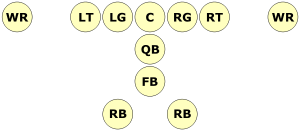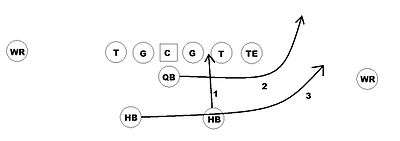Triple option
The triple option is an American football scheme used to offer several ways to move the football forward on the field of play. The triple option is based on the option run, but uses three players who might run with the ball instead of the two used in a standard option run.
The triple option forces defenses to worry about multiple running options on a single play. For the offense, the decision of who is to carry the ball—which option to use—is made during the play by the quarterback (QB).[1] The QB makes the decision whether to give the ball to the fullback (FB) or to keep the ball based on what the defensive end (DE) does. If the DE focuses on the FB, then the QB can keep the ball himself instead of handing it off. If the DE runs straight upfield or directly at the QB, then the QB gives the ball to the FB. The triple option can be complemented by fixed running plays which look like the triple option when they start, but use traditional blocking, as well as play-action passing.
There are three basic forms of triple option: the wishbone triple option, the veer triple option, and the I formation triple option. These differ in terms of the personnel on the field and their positioning prior to the start of the play.
Wishbone

The wishbone triple option can use several formations including the flexbone or Maryland I. The wishbone triple option is a running play where either the fullback, the quarterback, or one of the halfbacks (also called "running backs" [RB] or "tail backs") runs the ball.
First, the quarterback receives the football from the center. The quarterback then starts the play in one direction by appearing to hand the football to the fullback right behind the play side guard on a standard fullback dive play. The guard "chips" the 3-technique (defensive tackle) and blocks the play side (the side where the play is going) inside linebacker (usually called the "mike", or middle linebacker). The quarterback then reads the unblocked defensive lineman. If the lineman attacks the fullback, the quarterback pulls the ball from the fullback's gut and continues down the line, but if the defensive lineman goes outside to contain the play, he hands off inside to the fullback. The offensive tackle on the side of the play's direction does not block the defensive end and instead moves to block the first threat, usually the linebacker stacked behind the defensive end. In the traditional triple option the backside tailback will take a parallel course down the line of scrimmage keeping a three to five yard separation from the quarterback. If the defensive end comes inside toward the quarterback, he will pitch it outside to the trailing halfback. If the defensive end retains outside leverage and plays the trailing halfback, the quarterback will keep the ball and run upfield inside of the defensive end. The tailback to the play side is responsible for blocking one of the defensive backs, usually one of the deep safeties. The wide receiver (WR) to the play side is responsible for blocking the corner back assigned to cover them if the defense were playing man coverage.
If this is run properly it can be extremely effective as most all defensive players are accounted for by blockers. Once the quarterback or tailback gets beyond the line of scrimmage there should be nobody in front of him because the tackle, guard, tailback, and wide receiver are all downfield picking up the first threat.
The play is called the triple option as the fullback dive is the first option, the quarterback keeping the ball is the second option, and the quarterback pitching to the halfback is the third option.
A slight variation of this formation is the "flexbone", where the running backs move to just outside the tackles, but still behind the line of scrimmage. The running back that the play is using for the third option motions in, and while in motion the ball is snapped. The triple option, in this case, is still run mostly the same as the wishbone.

Veer
The veer triple option uses two halfbacks and a tight end (TE). The "inside veer" play is similar to the wishbone triple option, but the dive option is performed by the halfback on the side of the play, and the other halfback becomes the pitch man. The veer is more challenging to run to the weak side (the side without the tight end) because there is no lead blocker for the pitch man. The "outside veer" moves the halfback dive option outside the offensive tackle, forcing the outside linebacker to stop the halfback dive, and forcing the defensive backs to play the pitch option.
I formation
The triple option can be run out of the I formation as well. With two running backs, it is sometimes called the "I-veer", as the play is similar to the two running back veer offense. Three running back I formations such as the Maryland I and the stack I are more similar to the wishbone play.
Recent variations
In recent years, as spread and zone read offenses have become popular, many teams have begun to run variations of the triple option with the quarterback in the shotgun. This has been greatly popularized by the success of coaches such as Rich Rodriguez, Mark Helfrich, and Urban Meyer. The more traditional version of the triple option uses a quarterback under center and is advocated by the service academy coaches, including Fisher DeBerry, formerly of Air Force, and Paul Johnson, formerly head coach of Navy and now head coach at Georgia Tech (who installed this offense at Hawai'i and Georgia Southern, the latter school winning several Division I Football Championship Subdivision titles using it). Paul Johnson has had the most success with the triple option/veer in the last few years. The triple option can be used in the spread offense. Teams like Ohio State, Oregon, and Arizona have used an inside zone triple option from the spread. The quarterback reads the defensive end for "give" or "keep". If the defensive end squeezes down to take the dive, the quarterback will pull the ball and take his reading progression to the outside linebacker or defensive back. If the linebacker/defensive back takes the quarterback, the quarterback will pitch the ball to his running back who is running in formation with the quarterback.
References
- ↑ "Dissecting Navy's triple-option offense". The San Diego Union-Tribune. Retrieved 2015-08-14.
External links
- 1968 Houston Veer Playbook
- 1979 Mississippi Veer Playbook
- 1990's Georgia Southern Option Playbook
- 1990's Rice Veer Playbook
- 1997 Nebraska Option Playbook
- 1998 Air Force Flexbone Playbook
- 1999 Syracuse Freeze Option Playbook